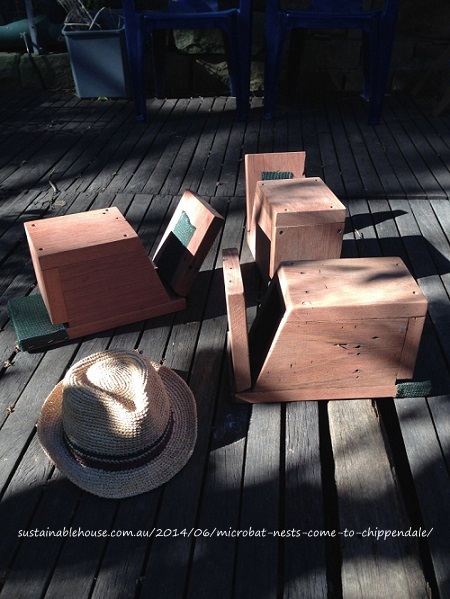Microbat nests come to Chippendale tvwc.org.au / building microbat nestbox.pdf also - sustainablehouse / microbat-houses-up-today-bri...
- Microbat nests come to Chippendale
- tvwc.org.au / building microbat nestbox.pdf
- also - sustainablehouse / microbat-houses-up-today-bring-em-on
Microbats can be as small as a knuckle on a human finger. They eat mozzies – over a thousand a day! They have been dying out as we cut down trees in our cities. These new houses will provide a home and refuge for them in Chippendale. This is what Tweed Shire Council says about microbats:
“Microbats make up one fifth of all Australian mammals, comprising over 60 species, in 6 families. Mostly roosting in colonies to maintain temperature and humidity, these endearing but little understood animals roost in caves, mine shafts, tree hollows, cracks in rocks and fence posts, in the walls and roofs of old
buildings, and sometimes even turn up in mailboxes. Microbats can be broadly divided into ‘cave-dwelling’ and ‘treedwelling’.
Over 50 percent of Australia’s microbats are ‘tree-dwelling’, which means they, like many mammals, are very dependent on tree hollows. Breeding normally take place in autumn to winter, depending on the climate, with mothers usually giving birth to one and sometimes two babies, born around November to December, after a 12 week pregnancy. After birth, the young pup will attach itself to a nipple in the wing pit, staying there until old enough to be left in crèche at the roost, with the other pups. Here they remain warm and safe while the mothers are away feeding. On her return, the mother will call to her young which answers back. Young microbats begin to fly from around 5 to 6 weeks of age.
Some Microbats are so small that a full grown adult can weigh as little as 3 grams. Feeding mostly on
insects such as moths, beetles, and mosquitoes, a single Microbat can consume up to 40% of its own body weight per night – up to an incredible 500 insects per hour. As you can see, there is a distinct advantage to having a healthy population of these little critters around your house or farm.”
You can download a pdf and drawings from the Council here: www.tv…
The photo of the nest boxes on my back deck shows their size in comparison to my hat.
Filed under Blog · Tagged with Biodiversity, Food security, Native knowledge













COMMENTS